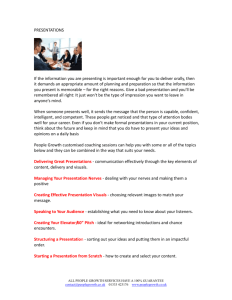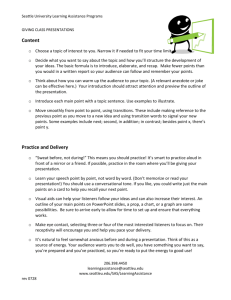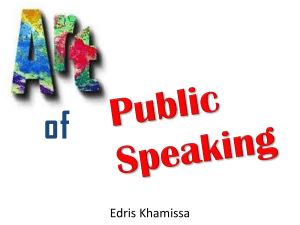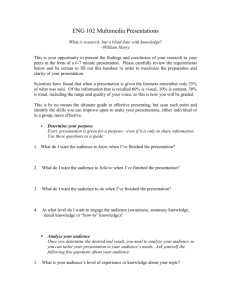File
advertisement
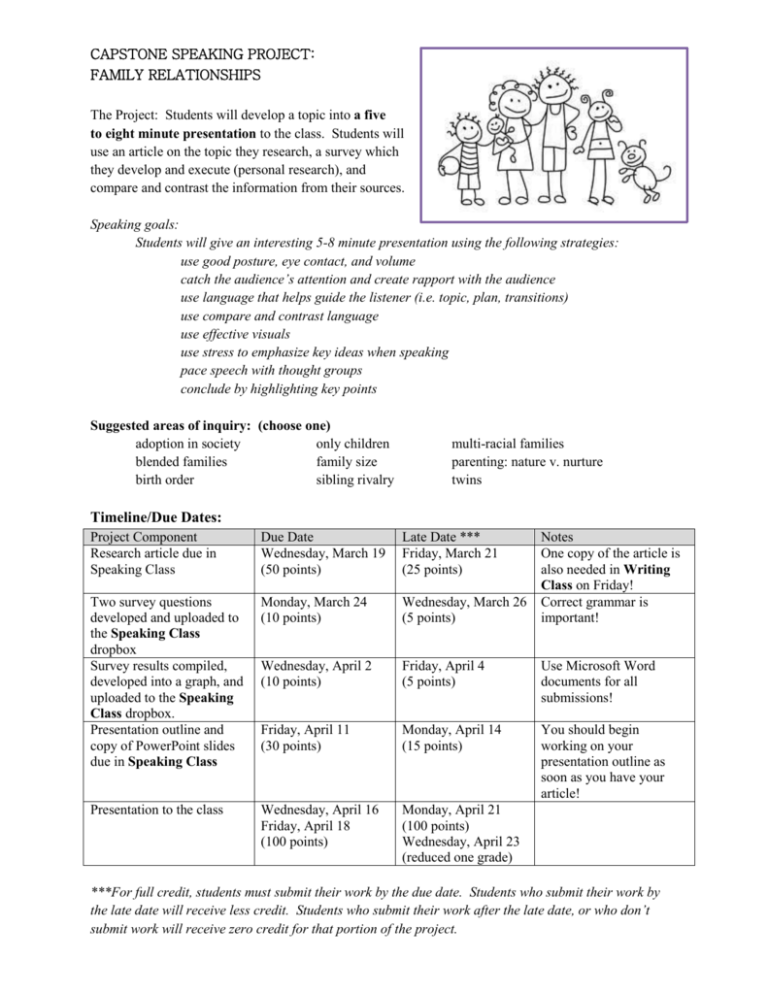
CAPSTONE SPEAKING PROJECT: FAMILY RELATIONSHIPS The Project: Students will develop a topic into a five to eight minute presentation to the class. Students will use an article on the topic they research, a survey which they develop and execute (personal research), and compare and contrast the information from their sources. Speaking goals: Students will give an interesting 5-8 minute presentation using the following strategies: use good posture, eye contact, and volume catch the audience’s attention and create rapport with the audience use language that helps guide the listener (i.e. topic, plan, transitions) use compare and contrast language use effective visuals use stress to emphasize key ideas when speaking pace speech with thought groups conclude by highlighting key points Suggested areas of inquiry: (choose one) adoption in society only children blended families family size birth order sibling rivalry multi-racial families parenting: nature v. nurture twins Timeline/Due Dates: Project Component Research article due in Speaking Class Due Date Wednesday, March 19 (50 points) Late Date *** Friday, March 21 (25 points) Notes One copy of the article is also needed in Writing Class on Friday! Correct grammar is important! Two survey questions developed and uploaded to the Speaking Class dropbox Survey results compiled, developed into a graph, and uploaded to the Speaking Class dropbox. Presentation outline and copy of PowerPoint slides due in Speaking Class Monday, March 24 (10 points) Wednesday, March 26 (5 points) Wednesday, April 2 (10 points) Friday, April 4 (5 points) Use Microsoft Word documents for all submissions! Friday, April 11 (30 points) Monday, April 14 (15 points) You should begin working on your presentation outline as soon as you have your article! Presentation to the class Wednesday, April 16 Friday, April 18 (100 points) Monday, April 21 (100 points) Wednesday, April 23 (reduced one grade) ***For full credit, students must submit their work by the due date. Students who submit their work by the late date will receive less credit. Students who submit their work after the late date, or who don’t submit work will receive zero credit for that portion of the project. CAPSTONE SPEAKING PROJECT: FAMILY RELATIONSHIPS Find an article Choose a topic from the list that interests you. Do research and find an article that is related to your topic. You will begin your search in Integrated Skills Class on Tuesday, March 18th. You will also use this article for Writing Class to write a reaction essay. Choose your article carefully! Don’t worry about the date of your article. It’s not necessary to have current information. It is more important to choose an article that is interesting and that you can understand well. Make at least 3 copies of your article: one copy is for you, one copy is to give to Cathy in Listening Class, March 19th, and one copy is to give to Dustin in Writing Class on March 21st. Create and conduct a survey, compile results in a graph After reading and understanding your article, think of two questions related to the article that you can ask people for your survey. Please check your grammar carefully! You will need to upload the questions to the dropbox for teacher approval. After you get approval, you will conduct a survey of at least 10 people with your questions. After you have finished conducting your survey, you will compile your results in a graph. Upload your graph and survey results to the dropbox before the due date! Presentation outline and Power Point slides All students must use Power Point slides to help clarify their ideas for listeners during the presentation. You will be able to use a maximum of six Power Point slides for this presentation. Your presentation will be between five and eight minutes and should include: I. II. III. IV. V. an interesting introduction which explains your topic a summary of the important information in your research article, including source citation an explanation of your survey and survey results, including a graph a comparison and/or contrastive analysis of all the information from your sources (your research article and your personal research survey) a conclusion that highlights the key points of your presentation Begin working on your presentation early! Be aware of due dates. You should begin working on your outline and composing your presentation as soon as you have chosen your research article. The following pages in Lecture Ready 3 will be helpful to you: p.12-13 using good posture, eye contact, and volume p. 24-25 strategies for a good introduction p.38-39 using transitions in a presentation p. 50-51 strategies for creating rapport with your audience p.64-65 using stress to emphasize key ideas p.76-77 pacing your speech using thought groups p.83 language that signals comparisons and contrasts p.90 using effective visuals p.121 language for citing information p.128 highlighting key points and delivering a take-home message Presentations!!!! Presentations will be April 16, 18 and 21. Students who are not able/ready to give their presentations on one of these days will be allowed to present on April 23. However, one letter grade will be deducted because of lateness, i.e. an ‘A will become a ‘B’ or a ‘B’ will become a ‘C’. No other makeup dates will be allowed. Note: All presentations will be video-recorded for grading purposes. Analytic Oral Presentation Rubric: UP Content/Development Excellent 20 19 18 points Good 17 16 points Average 15 14 points Low 13 12 11… points You fully and clearly explain ideas, using plenty of details. When appropriate, you add personal opinions. You are able to express some complex ideas. You explain main ideas clearly. However, you do not use enough details to fully explore parts of the topic. Your main ideas are clear. However, you may not have completed all the required parts of the assignment. Your presentation may be too simple. You use few details to explain your ideas. You have not completed important parts of the assignment. Your presentation is too short or too long. interesting introduction, summary of research article, citation, survey results, graph, comparative analysis, conclusion with key points Overall Comprehensability Excellent 20 19 18 points Good 17 16 points Average 15 14 points Low 13 12 11… points It is easy for listeners to understand all of your ideas. It takes some effort for listeners to understand you, but listeners understand all of your ideas. It may sometimes take a lot of effort for listeners to understand you, but listeners can understand your main ideas. Listeners may have to ask you to clarify a few words or details. With a lot of effort listeners can understand some of your ideas, but some important ideas are not clear. Listeners may have to ask you to clarity main ideas. Excellent 10 9 points Good 8 points Average 7 points Low 6 5 4… points It is always easy to follow the organization of your presentation. Your introduction is clear. Your conclusion summarizes your ideas and leaves the audience thinking about the topic. Your ideas are usually well organized, though there may be one part that doesn't connect well with the rest. You have an introduction and conclusion, but one or both of these are brief or do not keep the audience's attention. Parts of your presentation are organized, but other parts are not. In some parts you jump around from one point to another without a clear connection. Your introduction and conclusion are so brief that the audience doesn't understand. You do not follow a clear plan in discussing your ideas. Listeners find it difficult to understand the connection between ideas. You may not have an introduction and/or conclusion. Organization language for topic, plan, transitions, compare and contrast language, take-home message Use of Visuals Excellent 10 9 points Good 8 points Average 7 points Low 6 5 4… points Your visuals are interesting and relevant to the information in your presentation. It is easy for the audience to see and understand your visuals Your visuals are interesting and relevant to the information in your presentation. However, it is sometimes difficult for the audience to see or understand your visuals. Some of your visuals are not relevant to the information in your presentation, and it is sometimes difficult to understand your visuals. Your visuals are not relevant to your presentation OR your visuals contain too much text OR you read to your audience from your visuals OR you did not use visuals. maximum six power point slides, limited text (24pt. font-6 lines) contrastive text/background Grammar Excellent 10 9 points Good 8 points Average 7 points Low 6 5 4… points You use a variety of grammatical structures. When you use basic structures you make only a few errors. When you use more complex structures, you may make more errors, but listeners always understand your ideas. You generally use only basic grammar structures. You may make some errors, especially in verb tense, word order, or word form. However, grammar mistakes do not make meaning unclear. You make frequent errors in the basic grammar structures. Grammar mistakes may make some parts of your presentation unclear, but listeners understand your main ideas. Grammar mistakes are very basic. (For example, you might confuse "he" and "she.") Grammar mistakes make the meaning of important ideas unclear. Excellent 10 9 points Good 8 points Average 7 points Low 6 5 4… points Your pronunciation is clear. You use correct sentence and word stress and produce clear sounds. Key words are pronounced correctly. You use stress to emphasize key words. You pace your speech using thought groups. You occasionally mispronounce sounds or you stress syllables incorrectly. However, you pronounce key words correctly. You use stress to highlight key ideas, and you attempt to pace your speech using thought groups; listeners can understand your ideas. You may pronounce some words incorrectly or use inappropriate stress. You attempt to use stress to highlight key ideas, but there is no attempt to pace your speech using thought groups; listeners can understand main ideas, but may not understand all your details. Pronunciation problems sometimes make meaning unclear. Listeners cannot understand one or more important ideas. You mispronounce key words. There may be no attempt to use stress to emphasize key ideas or to pace your speech using thought groups. Excellent 10 9 points Good 8 points Average 7 points Low 6 5 4… points You speak smoothly, with only a few unnatural pauses. Your speech is not always smooth and may be slow. You may sometimes hesitate or pause, but listeners can understand your ideas easily. Your speech may be slow and/or choppy; You may pause and repeat or rephrase words. Listeners may have problems following your ideas because of frequent pauses. Your speech is slow and choppy. You often hesitate or rephrase your words. Fluency problems make it difficult or impossible for listeners to understand important ideas. Pronunciation Fluency Non-Verbal Communication Excellent 10 9 points Good 8 points Average 7 points Low 6 5 4… points You have excellent eye contact with your audience. You are confident and relaxed. Your gestures and facial expressions help you to connect with your audience. You usually have good eye contact. You sometimes use gestures and facial expressions to connect well with your audience. You sometimes have good eye contact; other times you read directly from your notes or your power point. You do not form a close connection with your audience. You rarely or never look at your audience. You read from you’re your power point or your notes for extended periods of time. You do not connect with your audience.
